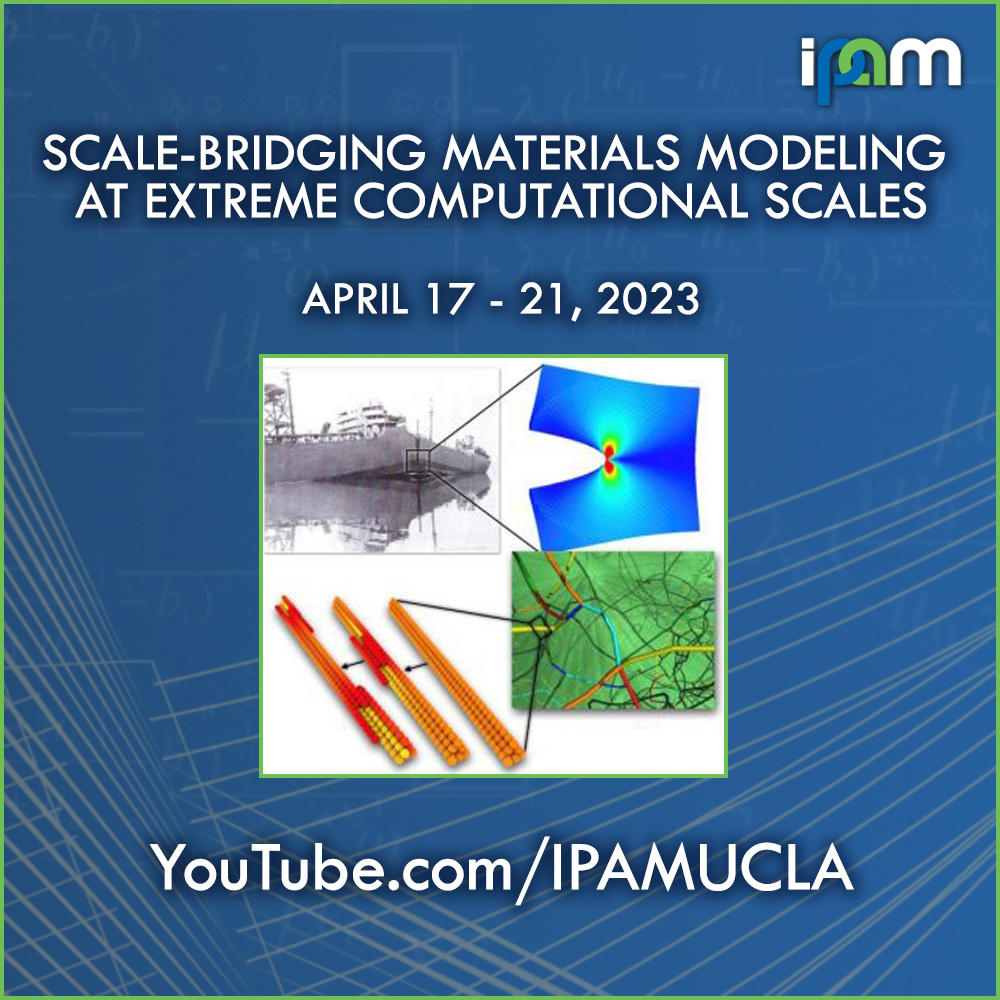Sambit Das - Computation of core energetics of pyramidal dislocation in Mg & Mg-Y alloy using DFT-FE
Presenter
April 21, 2023
Abstract
Recorded 21 April 2023. Sambit Das of the University of Michigan presents "Ab-initio computation of core energetics of pyramidal dislocations in Mg and Mg-Y alloy using DFT-FE: implications towards ductility enhancement" at IPAM's workshop for Scale-Bridging Materials Modeling at Extreme Computational Scales.
Abstract: Dislocation energetics play a significant role in controlling the ductility of magnesium, which has generated significant interest due to it high specific strength. Recent work (Science 359, 447-452 (2018)) suggests a pyramidal screw dislocation cross-slip based mechanism to significantly enhance the ductility of magnesium by controlling the dislocation energetics through dilute solution alloying. The key inputs to the associated line tension based mechanistic model for the cross-slip activation barrier prediction are the core energy difference between the screw dislocations dissociated on pyramidal I and II planes in pure magnesium (EPyrI-II), and the difference of the dislocation-solute interaction energies (UI-II) for various near-core sites. However, accurate estimation of both these quantities using explicit Kohn-Sham DFT calculations have so far been out of reach using plane-wave codes as large system sizes containing thousands of atoms are required to accurately resolve the relevant physics in the dislocation core. In this talk, I will first present a massively parallel real-space DFT framework (DFT-FE) [1-3] based on a local real-space variational formulation and discretized with higher-order adaptive spectral finite-element. DFT-FE has enabled fast and accurate DFT calculations on generic material systems reaching ~100,000 electrons and demonstrate an order of magnitude performance advantage over widely used plane-wave codes both in CPU-times and wall-times. Subsequently, using DFT-FE, we conduct a systematic cell size study of EPyrI-II till ~3,500 atoms (35,000 electrons) per periodic layer along the dislocation line. We find that a cell-size of ~2,700 atoms is required to obtain the sensitive EPyrI-II input under the desired cell-size error of 5 meV/nm. Similarly, to compute the spatially dependent UI-II inputs in the Mg-Y alloy, we find cell sizes of ~6,000 atoms involving a longer periodic length are required. Next, we discuss how the above first-principles inputs are incorporated into an improved mechanistic model of the cross-slip activation barrier, that includes the missing physics of (i) influence of non-glide stresses on EPyrI-II and (ii) Y solute concentration dependent critical resolved shear stress (CRSS) of pyramidal I and II screw dislocations. We demonstrate that the above aspects significantly influence the predicted cross-slip barrier in Mg and Mg-Y alloy, and finally we provide quantitative predictions of Y concentration ranges where cross-slip occurs at a much faster rate leading to enhanced ductility in Mg-Y alloy.
[1] Das, S., Motamarri, P., Subramanian, V., Rogers, D. M., & Gavini, V., (2022), DFT-FE 1.0: A massively parallel hybrid CPU-GPU density functional theory code using finite-element discretization, Comput. Phys. Commun. 280, 108473.
[2] Motamarri, P., Das, S., Rudraraju, S., Ghosh, K., Davydov, D., Gavini, V., 2020, DFT-FE: A massively parallel adaptive finite-element code for large-scale density functional theory calculations, Comput. Phys. Commun. 246, 106853.
[3] Das, S., Motamarri, P., Gavini, V., Turcksin, B., Li, Y.-W., Leback, B., 2019, Fast, scalable and accurate finite-element based ab initio Calculations using mixed precision computing: 46 PFLOPS simulation of a metallic dislocation system, SC19.
Learn more online at: http://www.ipam.ucla.edu/programs/workshops/workshop-ii-scale-bridging-materials-modeling-at-extreme-computational-scales/
